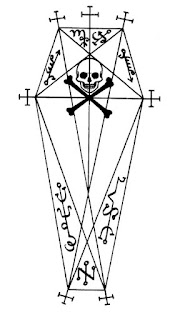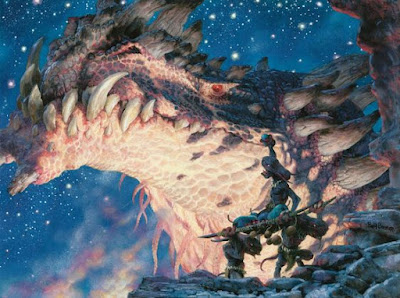The Holy Dead: A New Paradigm for Undeath
The gods abhor the undead. It has always been so. Yet, they speak of distant lands where the dead are raised by priests. They speak of the honored dead, mummified and buried with sacred rites to rise again as guardians of sacred places. They whisper of soldiers raised again and again, losing a little bit of themselves each time. They speak of the corpses of saints carried into battle, working fell magics on the killing fields.
It has always been strange to me that in D&D, the undead and the divine don't get along. Since most D&D is in a medieval fantasy setting, it is strange that we should overlook some of the aesthetics of medieval Catholicism that are not just inoffensive benevolence. Lest we forget, each cathedral would come with depictions of the crucified Christ, a man bleeding and dying, tortured on the cross, a crown of thorns on his head. To this day, Catholics maintain sacred relics that are the bones of saints or the death shroud of Christ. Ancient Gothic cathedrals have an edge of the grim in their countless statues of the saints. Catholics still today venerate dead saints.
So I propose: first off, that our D&D religions ought to not cling to this standard where every god is just light and goodness. The gods of fantasy that resonate with me are gods like Rhyllor, the Red God from Game of Thrones. I like the edge of mystery and darkness that their priests wield. This also would likely mean that the line between wizard and cleric would become mostly irrelevant.
Second, the line between religion and undeath in fantasy settings ought to be reexamined. I attempt to do so here. This is not only a brainstorming of the ways that undeath and religion could get along but indeed a proposal for a new paradigm of undeath.
All undead arise from divine magic.
They guard ancient temples and burial grounds willingly. In Cadromar, the holy men know that heaven awaits so they are buried, cremated, or mummified with sacred spells, such that they may rise and maintain the temple. Their soldiers die on the battlefield and are raised by vivicist priests, only to lose a little of their humanity each time. Adventurers must learn the truth of such undead if they seek to loot the tombs of Cadromar, for their coffins hide much treasure and the bodies of the holy dead are often valuable, in and of themselves. Wizards snuff their corpse ash to see visions. Rogue clerics can use the bodies of saints as sources of power. There is much to gain and much to lose for the tomb raider willing to take the risk.
Maintainer Spirits:
Who maintains the dungeon? Who resets the pit traps and restocks the dart traps? Who cleans away the corpses? Temple catacombs in Cadromar are home to many treasures. The dead are interred with their worldly valuables that they might drop these things as a final sacrifice to the Hungry God who guards the Black River of Shaioun. The holy dead are sometimes mummified to be Maintainers. Their canopic jars are scattered, hidden throughout the catacombs and their mummy is hidden in a safe place. Everywhere there are jars and so long as the mummy is intact, their spirit will operate, reload, and restock traps in the area near their jars. They will also clean, disposing of dead tomb-raiders, and setting right any destroyed parts of the catacombs. All of this will happen out of sight in hours when few men wake.
Dwarves are also said to keep shrines to their ancestors in the dungeons and fortresses that they have built and these ancestral specters will fulfill the same purpose.
Tomb Knights:
Temple Guardians can take many forms. Only in an especially poor or desperate situation would such undead be unarmored, ragged corpses or shambling skeletons. Honorable knights and warrior clerics are honored to be interred in full sets of armor, these would be powerful warriors in life and they would remain thus in death, however it would be far rarer to see these guardians in great numbers due to the need for exceptional warriors. These Tomb Knights would be clad in fine armor that would be crafted out of their worldly treasures. If a Tomb Knight should be slain, their armor would go for a fine price. Of course, Tomb Knights never stay dead for long, so speed in such disrobing might be required.
Most undead, including Tomb Knights maintain their personalities from life. Their duty to protect the tomb is absolute, but they might be reasoned with, fooled, or be convinced to be merciful. As knights, themselves, many would-be amenable to helping out with a good cause or holy quest, though they cannot leave their catacombs, they might allow adventurers to take hold of an artifact that they claim they need on their quest. There are stories of Tomb Knights catching young starving thieves in the act, but taking some piece of their own precious armor off and giving it to them and telling them not to return.
Trial Keepers:
Most obnoxious and most powerful of the holy dead. Often sacred artifacts of great power are guarded by trials such that only the most worthy may lay claim to them. These trials are overseen by powerful spirits: martyred saints or mighty heroes. These specters are often powerful enough to bend reality itself, forcing those who come to lay claim to the artifact to travel strange and far off lands or live entire lifetimes in another era or walk in the shoes of some old hero, facing what dangers they faced. In their trial chambers, these spirits are invulnerable, godlike, and utterly unreasonable.
However, their single-minded determination to subject people to their obscure tests can be used against them. While such a spirit might be distracted by putting someone a party member through a trial, another party member might go through the catacombs to find where the body of the Trial Keeper is interred. If the corpse or mummy can be destroyed, the Trial Keeper spirit will vanish.
The Undying:
In a world where clerics can heal from death or near-death. One might reasonably wonder how anyone dies. Why would someone refuse to be healed given the opportunity? The Hungry God must be satisfied. Every life pulled from death's clutches, must leave some behind. People who have been returned to life by the vivicists of Cadromar lose part of their soul in the process. Each time, they lose more memories of treasured times, forgetting even the faces of their fathers and mothers. Each time, they become less human, less able to focus on their work, less capable of creativity or wit.
None know this better than the Undying, titles granted to soldiers who have died many times in battle. Not every soldier is capable of fighting after they have been raised. Many just lose the spark of life in them and return to lives of farming and domestic bliss. This is even a blessing for some. Violent men return placid. Insatiable drunks return with little thirst. But almost always something more is missing that never quite comes back, some part of them lost forever.
The Undying, by contrast, become only more vicious with each death. Raised again and again, war replaces everything in them that they once cared about and they become nothing but engines of death. More than one Undying soldier has gone totally feral, raised too many times, and completely lost anything inside them but the desire to kill. These feral bands of Undying haunt devastated battlegrounds, or lurk in the forests where they once waged guerilla warfare.
It is said, however, that if something of emotional value can be brought before a feral Undying, they might be stunned or even regain some of their true selves for a moment. This does not last long. The Hungry God never returns what he takes. But it might provide an advantage in an encounter with the Undying.
Second, the line between religion and undeath in fantasy settings ought to be reexamined. I attempt to do so here. This is not only a brainstorming of the ways that undeath and religion could get along but indeed a proposal for a new paradigm of undeath.
All undead arise from divine magic.
They guard ancient temples and burial grounds willingly. In Cadromar, the holy men know that heaven awaits so they are buried, cremated, or mummified with sacred spells, such that they may rise and maintain the temple. Their soldiers die on the battlefield and are raised by vivicist priests, only to lose a little of their humanity each time. Adventurers must learn the truth of such undead if they seek to loot the tombs of Cadromar, for their coffins hide much treasure and the bodies of the holy dead are often valuable, in and of themselves. Wizards snuff their corpse ash to see visions. Rogue clerics can use the bodies of saints as sources of power. There is much to gain and much to lose for the tomb raider willing to take the risk.
Maintainer Spirits:
Who maintains the dungeon? Who resets the pit traps and restocks the dart traps? Who cleans away the corpses? Temple catacombs in Cadromar are home to many treasures. The dead are interred with their worldly valuables that they might drop these things as a final sacrifice to the Hungry God who guards the Black River of Shaioun. The holy dead are sometimes mummified to be Maintainers. Their canopic jars are scattered, hidden throughout the catacombs and their mummy is hidden in a safe place. Everywhere there are jars and so long as the mummy is intact, their spirit will operate, reload, and restock traps in the area near their jars. They will also clean, disposing of dead tomb-raiders, and setting right any destroyed parts of the catacombs. All of this will happen out of sight in hours when few men wake.
Dwarves are also said to keep shrines to their ancestors in the dungeons and fortresses that they have built and these ancestral specters will fulfill the same purpose.
Tomb Knights:
Temple Guardians can take many forms. Only in an especially poor or desperate situation would such undead be unarmored, ragged corpses or shambling skeletons. Honorable knights and warrior clerics are honored to be interred in full sets of armor, these would be powerful warriors in life and they would remain thus in death, however it would be far rarer to see these guardians in great numbers due to the need for exceptional warriors. These Tomb Knights would be clad in fine armor that would be crafted out of their worldly treasures. If a Tomb Knight should be slain, their armor would go for a fine price. Of course, Tomb Knights never stay dead for long, so speed in such disrobing might be required.
Most undead, including Tomb Knights maintain their personalities from life. Their duty to protect the tomb is absolute, but they might be reasoned with, fooled, or be convinced to be merciful. As knights, themselves, many would-be amenable to helping out with a good cause or holy quest, though they cannot leave their catacombs, they might allow adventurers to take hold of an artifact that they claim they need on their quest. There are stories of Tomb Knights catching young starving thieves in the act, but taking some piece of their own precious armor off and giving it to them and telling them not to return.
Trial Keepers:
Most obnoxious and most powerful of the holy dead. Often sacred artifacts of great power are guarded by trials such that only the most worthy may lay claim to them. These trials are overseen by powerful spirits: martyred saints or mighty heroes. These specters are often powerful enough to bend reality itself, forcing those who come to lay claim to the artifact to travel strange and far off lands or live entire lifetimes in another era or walk in the shoes of some old hero, facing what dangers they faced. In their trial chambers, these spirits are invulnerable, godlike, and utterly unreasonable.
However, their single-minded determination to subject people to their obscure tests can be used against them. While such a spirit might be distracted by putting someone a party member through a trial, another party member might go through the catacombs to find where the body of the Trial Keeper is interred. If the corpse or mummy can be destroyed, the Trial Keeper spirit will vanish.
The Undying:
In a world where clerics can heal from death or near-death. One might reasonably wonder how anyone dies. Why would someone refuse to be healed given the opportunity? The Hungry God must be satisfied. Every life pulled from death's clutches, must leave some behind. People who have been returned to life by the vivicists of Cadromar lose part of their soul in the process. Each time, they lose more memories of treasured times, forgetting even the faces of their fathers and mothers. Each time, they become less human, less able to focus on their work, less capable of creativity or wit.
None know this better than the Undying, titles granted to soldiers who have died many times in battle. Not every soldier is capable of fighting after they have been raised. Many just lose the spark of life in them and return to lives of farming and domestic bliss. This is even a blessing for some. Violent men return placid. Insatiable drunks return with little thirst. But almost always something more is missing that never quite comes back, some part of them lost forever.
The Undying, by contrast, become only more vicious with each death. Raised again and again, war replaces everything in them that they once cared about and they become nothing but engines of death. More than one Undying soldier has gone totally feral, raised too many times, and completely lost anything inside them but the desire to kill. These feral bands of Undying haunt devastated battlegrounds, or lurk in the forests where they once waged guerilla warfare.
It is said, however, that if something of emotional value can be brought before a feral Undying, they might be stunned or even regain some of their true selves for a moment. This does not last long. The Hungry God never returns what he takes. But it might provide an advantage in an encounter with the Undying.



I ran a viking-themed game for five years, and since a lot of viking magic centers around necromancy and Odin is the god of the slain, the hanged one, etc., undead were "holy" in that setting. It took a little bit for new players to wrap their head around, but I was satisfied with the way it played out.
ReplyDeleteUndead weren't evil, they were _doing their jobs_: guarding tombs, avenging wrongs, working the will of gods and sorcerers.
I was kind of thinking about Skyrim Draugr when I wrote this. That sounds like a cool game!
DeleteWhile I understand the impulse, the reason why Undead are thought of as evil is because of another fundamentally Christian idea, that death is a punishment and a result of the fall. As such, all Good Christians should prepare themselves for death, which can come swiftly or in unexpected ways.
ReplyDeleteBut in a setting where the extension of life and the defiance of death is possible, such a thing is blasphemous, a rebellion against God's authority. The Author of Life determines when you live and die, to defy Him would be regarded as the height of hubris, wickedness on par with the Adversary.
Similarly, raising the dead as Undead is a Satanic inversion of Christ's Resurrection, for instead of raising to the fullness of life, it raises the dead either as hollow husks or tortured souls who can feel nothing but pain, trapped in cages of rotting meat.
That is why Undeath, the Undead and the Necromancer are abominations.
I get that, as a Christian myself. It would seem that the restoration of rotting corpses to be a foul perversion of the resurrection to come. The torturing of souls is another aspect which I did not consider. I think these are things that people should consider more with the undead in settings. Someone did a good post on it recently where it seems like no one actually considers why undeath happens or what it really means for the setting. These are all good things to consider so that undead actually mean something and are not just sword fodder.
DeleteThis is a really interesting inversion of the concept, I like this a lot. You could also imagine this being a single faction or kingdom in a broader fantasy setting, and maybe they're seen as heretical, or not, but anyway it could work standalone or in a bigger setting.
ReplyDeleteI've also thought a little about the idea of death and Catholicism, although I'm definitely not as educated on it as you seem to be. But in particular the idea that saints and vampires are two sides of the same coin, with saints body's being checked some time after their death to look for signs of resurrection like nail growth. I think the holy vampire / anti-vampire saint thing could come into play here as well.
It would make sense that saints and vampires are two sides of the same coin. Honestly, Dracula is a sort of anti-Christ in a lot of ways. I could see the priests of Cadromar maybe sustaining themselves off of the souls they drain in the resurrection process.
Delete